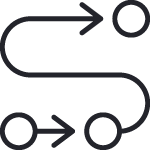Expertise
Areas of Specialization
Research Clusters
-
Professor
Chemical Engineering
Overview
My research interests are driven by the desire to be able to solve real life problems, which often leads to the need to develop a new type of a model, a new computational procedure, or a new software required for large-scale numerical experimentation.
Current research includes:
- Design an operation of inter-sector integrated energy systems
- Optimal production planning and scheduling
- Detection of faults and anomalies in plant operation.
- Hybrid models for process monitoring, control, and optimization.
- Real-time optimization and control of process operations.
Design and operation of inter-sector integrated energy systems.
The vision of this research program is to design net zero (GHG emissions) Inter-sector Integrated Energy Systems (IIES) for light industry, civic, and personal transportation sectors, without having to use CO2 capture and storage. These sectors currently emit about 40% of GHG emissions in Canada (NRCAN 2018).
Long term goals (5 to 10 yrs.) are to design net zero network of IIES clusters that are (i) resilient to subsystem failures, (ii) flexible to adapt to climate change, and (iii) maintain net zero GHG emissions as energy demands of integrated subsystems vary. Clusters will be classified based on the types of entities contained in them (e.g. one type of a cluster may contain hockey arena, residential building, bakery, and a brewery). Cross-sector integration of energy systems within clusters will make cluster GHG emissions lower than what is achievable by minimizing GHG emissions of individual sector separately.
Short term (next 5 yrs.) objectives are: (i) identify configurations of clusters (what types of civic building and of industrial plants) that lead to stable (steady) GHG emissions reduction even when individual subsystem demands vary (ii) determine integration topology so that the integrated systems are resilient & not vulnerable to cascading network failures, (iii) determine design patterns that provide flexibility with respect to changes in demand, (iv) define optimal roadmap to system configuration changes (structure and modular component capacities) to achieve GHG emissions of specified level, (v) optimal operation and integration with production scheduling, and (vi) determine the lowest possible, economically viable level of GHG emissions with presently available technologies and its dependence on carbon emissions tax.
Related recent publication: Afzali, F., et al. (2018, 2020, 2021), Li, R., et al (2021a, 2021b, 2022).
Optimal production planning and scheduling for continuous and discrete manufacturing plants
Research in this area aims to enable optimal decision making for large scale plants. Some of the solutions that we have proposed deal with:
- Under what conditions less efficient competitor should upgrade its plant and how much time is available to implement such an upgrade in order to prevent being eliminated by the more efficient competitors?
- How to ensure that the operating conditions for each period in a many-period production plan are optimal and as steady as possible (i.e. do not “bounce around” from period to period as a consequence of using a particular solver)?
- How to optimize operating conditions, production plans and schedules for large models corresponding to the real-life plants?
- How to account for uncertainty in production times of discrete multi-stage manufacturing processes?
As a part of the research, we have developed a GUI for plant model configuration in GAMS and have built a complete refinery model as an experimental workbench. This has enabled us to examine our solution methods on large problems which are much bigger than typically considered by the researchers in the area.
Recent publications: Li, F., et al. (2021a, 2021b, 2020), Mori, J., et al.(2015, 2017), Fu. G., et al (2018), Tominac, P., et al. (2017, 2018), Jalanko, M., et al. (2018a, 2018b, 2019), Castillo, C.P., et al. (2017a, 2017b).
Detection of faults and anomalies in plant operation
Our work on fault identification exploits knowledge of process model structure (network topology) to construct a causal network and novel Bayesian contribution indices within the probabilistic graphical network to identify the potential root-cause variables. We demonstrate that the use of the probabilistic graphical network significantly improves fault detection capabilities when compared to methods based purely on data (Mori, J. et al. 2015).
Anomalies are events that happen very rarely and often cause significant disruptions in production. Since the number of anomalies is very small, e.g. 2 or 3 per year), one can not collect a lot of data about them, which necessitates the use of unsupervised learning models. Our recent work (Meyer, K., et al. 2021) examines detection of anomalies in resistive steel welding.
Hybrid models for process monitoring, control, and optimization
Since there are limits to the size of the nonlinear plant models which can be used for optimal planning or scheduling, industrial practice is to use linear approximations of the plant equipment. This leads to errors in the production plans and schedules. In other words, deemed optimum is not really an optimum. Some published comparisons and our own work indicate that the errors introduced by the linearized model are on the order of 2% to 4% of the optimum (even with piecewise linearization).
Our research has developed a new class of wide-boiling distillation models (hybrid models), comprised of rigorous mass balances, energy balances, and of approximate models representing the internal working of a particular piece of equipment.
This modelling approach has enabled us to model e.g. crude distillation units for use in real-time optimization (RTO) and in scheduling and planning. The accuracy of these models is within 1% of the rigorous models. The models are very small: about 150 to 200 equations (much smaller than 10,000 to 20,000 equations for the nonlinear rigorous model). Using these models in refinery planning, we have been able to demonstrate that even with the best current modelling industrial practices, there is a substantial portion of the profits which are not realized due to the using lower accuracy CDU unit models.
Recent publications: Fu, G., et al (2016, 2018), Li, F., et al (2021), Jalanko, M., et al. (2021a, 2021b)
Real-time optimization and control of process operations
Economic optimization of real time operation of an equipment can be approached either as an optimization of an economic model predictive controller or as a dynamic real-time optimization. Both of these approaches can be recast as solving NLP problems.
Our recent work (Wang et al, 2017a) applies normalized parametric disaggregation (NMDT) to the economic optimization of NMPC. We demonstrate that a relatively simple algorithm, which can be implemented by advanced control engineers, ensures that globally optimal performance will be achieved. If performance needs to be optimized over a longer time horizon, the size of NMPC model becomes too large to solve it in real time. D-RTO decomposes the economic real-time optimization in two layers. The top layer (D-RTO) computes optimal operating trajectories, while the lower level (MPC) guides the operation along these trajectories. State of the art research in the area uses different models in NMPC and D-RTO layers, leading to the mismatch between the models and consequently to the issues in real time performance. The work we completed recently (Wang et al, 2017b) is the first work to use the same model in both layers, which improves the real-time performance and simplifies the implementation.
- Dipl. Ing, U. of Zagreb (Zagreb, Croatia)
- Ph.D., U. of Houston, (Houston, TX)
- Post-Doctoral Associate, M.I.T. (Cambridge, MA)
Design of Software for Process Simulation, Design, Optimization and Plant Operations
- Architecture for aspenONE (integrated solutions for plant operations) (2003-2006).
- Design of a real-time optimization system, RT-OPT and equation-oriented ASPEN PLUS. (1991-1994)
- Novel refinery-wide modeling. (1988-1991)
- Design and implementation of refinery scheduling / simulation software (1982-1984)
- Designed computational architecture for ASPEN PLUS. (1977-1978)
Design of Methods for Plant Control and Optimization
- Novel method for on-line calculation of distillation tower tray loading and control of tower operation close to the flooding operation.
- Novel advanced multivariable control methods.
- Globally optimal dynamic RTO without model mismatch between optimization and control layer.
Algorithms for production planning and scheduling
- Supply-demand pinch (inventory pinch) decomposition algorithm for large scale nonlinear multiperiod planning models.
- Global optimization of multiperiod nonlinear production planning model.
- Production planning under uncertainty in demand.
- Game theoretic framework for process plant competitive capacity planning.
Recent
- Meyer, K., Mahalec, V.*,”Anomaly Detection Methods for Infrequent Failures in Resistive Steel Welding”, Journal of Manufacturing Processes (2022) 75, March, 497-513 https://doi.org/10.1016/j.jmapro.2021.12.003
- Li, R., Mahalec, V.,* “Integrated Design and Operation of Energy Systems for Residential Buildings, Commercial Buildings, and Light Industries”, Appl Energy (2022) 305 (1st Jan) 117822 https://doi.org/10.1016/j.apenergy.2021.117822
- Li, R., Mahalec, V.,* “Greenhouse gas emissions reduction by cross-sector integration of energy systems: Optimal sizing of integrated entities”, Energy Conversion & Management (2021) 248 (15 Nov.) 114788 https://doi.org/10.1016/j.enconman.2021.114788
- Jalanko, M., Sanchez, Y., Mhaskar, P., Vladimir Mahalec, V.* “Flooding and Offset-free Nonlinear Model Predictive Control of a High-Purity Industrial Ethylene Splitter Using a Hybrid Model”, Comp. Chem. Eng. (2021) 155 (Dec.) 107514 https://doi.org/10.1016/j.compchemeng.2021.107514
- Tan,D., Huang,Z., Peng, X., Zhong, W., Vladimir Mahalec, V. (2021). “Deep adaptive fuzzy clustering for evolutionary unsupervised representation learning”. arXiv preprint. arXiv:2103.17086: 15 pages. https://arxiv.org/abs/2103.17086
- Li, R., Mhaskar, P., Mahalec, V.*, “Integration of Energy Systems for Buildings and Light Industrial Plants”, Energy (2021) 233 (15 Oct) 121120 https://doi.org/10.1016/j.energy.2021.121120
- Li, F., Qian, F*., Yang, M., Du, W., Long, J., Mahalec, V*., “Refinery production planning optimization under crude oil quality uncertainty” Comp. Chem. Eng. (2021), 151 (August) 107361 https://doi.org/10.1016/j.compchemeng.2021.107361
- Jalanko, M., Sanchez, Y., Mahalec, V., Mhaskar, P.*, “Adaptive system identification of industrial ethylene splitter: A comparison of subspace identification and artificial neural networks”, Comp. Chem. Eng. (2021) 147 (April) 107240 https://doi.org/10.1016/j.compchemeng.2021.107240
- Tan, D., Peng, X.*, Wang, Q., Zhong, W.*, Vladimir Mahalec, V.* (2021) Automatic determining optimal parameters in multi-kernel collaborative fuzzy clustering based on dimension constraint. Neurocomputing. 443(5 July): 58-74. https://doi.org/10.1016/j.neucom.2021.02.062
- Tan, D., Chen, L., Jiang, C, Zhong, W., Qian, F., Mahalec, V*., “A Circular Targets Feature Detection Framework based on DCNN for Industrial Applications,” IEEE Transactions on Industrial Informatics (2020), 17 (5) 3303-3313, doi:10.1109/TII.2020.3024578.
- D. Tan, W. Zhong, X. Peng, Q. Wang and V. Mahalec, “Accurate and Fast Deep Evolutionary Networks Structured Representation through Activating and Freezing Dense Networks,” in IEEE Transactions on Cognitive and Developmental Systems, (2020) doi:10.1109/TCDS.2020.3017100.
- Li, F., Qian, F., Yang, M., Du, W., Mahalec, V.*, “Product tri-section based crude distillation unit model for refinery production planning and refinery optimization”, AIChE J. (2021) 67: e17115, https://doi.org/10.1002/aic.17115
- Song, W., Mahalec, V.*, Long, J., Yang, M., Qian, F.*, “Modeling the Hydrocracking Process with Deep Neural Networks”, Ind. Eng. Chem. Res. (2020) 59 (7) 3077-3090 https://doi.org/10.1021/acs.iecr.9b06295
- Li, F., Qian, F., Fan, C., Mahalec, V.*, “Hinging hyperplane crude mixing model for production planning optimization”, Ind. Eng. Chem. Res. (2020) 59 (18) 8704-8714 https://doi.org/10.1021/acs.iecr.0c00124
- Afzali, S.F., Cotton, J., Mahalec, V.*, “Urban community energy systems design under uncertainty for specified levels of carbon dioxide emissions”, Applied Energy (2020) 259, Feb 1, 114084 https://doi.org/10.1016/j.apenergy.2019.114084
- Jalanko, M., Mahalec, V.* “Gasoline Blend Planning under Demand Uncertainty: Aggregate Supply–Demand Pinch Algorithm with Rolling Horizon”, Ind. Eng. Chem. Res. (2019) 59(1) 281-298 https://doi.org/10.1021/acs.iecr.9b00733
- Jalanko, M., Mahalec, V.*,” Supply-Demand Based Algorithm for Gasoline Blend Planning Under Time-Varying Uncertainty in Demand”, In: Ntalianis K., Vachtsevanos G., Borne P., Croitoru A. (eds) Applied Physics, System Science and Computers III. APSAC 2018. Lecture Notes in Electrical Engineering, vol 574. Springer https://doi.org/10.1007/978-3-030-21507-1_27
- Afzali, S.F., Mahalec, V.* “Novel performance curves to determine optimal operation of CCHP systems” Applied Energy (2018) 226, 1009-1036 https://doi.org/10.1016/j.apenergy.2018.06.024
- Castillo, C.P, Castro., P.*, Mahalec., V. “Global Optimization of MIQCPs with Dynamic Piecewise Relaxations” Journal of Global Optimization (2018) 71 (4) 691-716 https://doi.org/10.1007/s10898-018-0612-7
- Tominac, P., Mahalec, V.*, “A dynamic game theoretic framework for process plant competitive upgrade and production planning”, AIChE J. (2018) 64 (3) 916-925 https://doi.org/10.1002/aic.15995
- Jalanko, M., Mahalec., V.*, “Supply-demand pinch based methodology for multi-period planning under uncertainty with application to gasoline blend planning”, Comp. Chem. Eng. (2018) 119 (Nov.) 425-438 https://doi.org/10.1016/j.compchemeng.2018.09.016
- Jalanko, M., Mahalec, V.*, “Inventory pinch based algorithm for gasoline blend planning with uncertainty in component qualities”, Comp. Aided Chem. Eng., (2018) 44 , 1525-1530 https://doi.org/10.1016/B978-0-444-64241-7.50249-4
- Afzali, S. F., Mahalec, V.*, “Optimal design, operation and analytical criteria for determining optimal operating modes of a CCHP with fired HRSG, boiler, electric chiller and absorption chiller” Energy (2017) Energy (2017) 139, 1052-1065 https://doi.org/10.1016/j.energy.2017.08.029
- Fu, G., Castillo Castillo, P.A., Mahalec.,V.*, “Impact of crude distillation unit distillation model accuracy on refinery production planning”, Front. Eng. Manag. (2018) 5 (2), 195-201 https://doi.org/10.15302/J-FEM-2017052
- Wang, X., Qian, F., Mahalec, V.* ,“Globally optimal dynamic real time optimization without model mismatch between optimization and control layer”, Comp. Chem. Eng. (2017) 104(Sept. 2) 64-75 https://doi.org/10.1016/j.compchemeng.2017.04.006
- Wang, X., Qian, F., Mahalec, V*,. “Globally optimal nonlinear model predictive control based on multi-parametric disaggregation”, J. of Process Control, (2017) 52(4) 1-13 https://doi.org/10.1016/j.jprocont.2017.01.005
- Castillo, C.P, Castro., P.*, Mahalec., V,. “Global optimization algorithm for large-scale refinery planning models with bilinear terms”, Ind. Eng. Chem. Res. (2017) 56(2) 530-548 https://doi.org/10.1021/acs.iecr.6b01350
- Castillo, C.P, Castro., P., Mahalec., V.*, “Global optimization of nonlinear blend-scheduling problems”, Engineering (2017) 3 (2) 188-201 https://doi.org/10.1016/J.ENG.2017.02.005
- Tominac, P., Mahalec, V.*, “A Game Theoretic Framework for Petroleum Refinery Strategic Production Planning”, AIChE J. (2017) 63 (7) 2751-2763 https://doi.org/10.1002/aic.15644
- Mori, J., Mahalec, V.*, “Planning and Scheduling of Steel Plates Production. Part II: Scheduling of Continuous Casting”, Chem. Eng. (2017), 101 (9) 312-325 https://doi.org/10.1016/j.compchemeng.2016.01.020
- Wang, X., Mahalec, V., Qian, F., ”Real-time optimization and control of an industrial ethylbenzene dehydrogenation process”, Chem. Eng. Trans. (2017) 61 331-336 https://doi.org/10.3303/CET1761053
- Castillo Castillo, P.A., Mahalec, V.*, “Improved continuous-time model for gasoline blend scheduling”, Comp. Chem. Eng. (2016) 84, 627-646 https://doi.org/10.1016/j.compchemeng.2015.08.003
- Castillo Castillo, P.A., Mahalec, V.*, “Inventory pinch gasoline blend scheduling algorithm combining discrete- and continuous-time models”, Comp. Chem. Eng. (2016) 84, (Jan 4) 611-626 https://doi.org/10.1016/j.compchemeng.2015.08.005
- Fu, G., Y. Sanchez, Mahalec, V.*, ”Hybrid Model for Optimization of Crude Distillation Units”, AIChE J. (2016) 62(4) 1065-1078 https://doi.org/10.1002/aic.15086
- Mori, J, Mahalec, V.*, ‘Bayesian Inference in Hybrid Networks with Large Discrete and Continuous Domains”, Expert Sys. with App. (2016) 49 (May) , 1-19 https://doi.org/10.1016/j.eswa.2015.11.019
- Fu, G. Mahalec, V.*, “Comparison of methods for computing crude distillation product properties in planning and scheduling”, Ind. Eng. Chem. Res. (2016), 54 (45), pp 11371–11382; https://doi.org/10.1021/acs.iecr.5b02919
- Castillo Castillo, P., Castro, P., Fu, G., Mahalec., V.*, “Short-term crude mix and operating conditions optimization for oil refinery operations” Computer Aided Chemical Engineering (2016) 38 763-768 https://doi.org/10.1016/B978-0-444-63428-3.50132-6
- Chen, Y., Mahalec., V., Chen, Y., Liu, X., He, R., Sun, K., “Reconfiguration of satellite orbit for cooperative observation using variable-size multi-objective differential evolution”, European Journal of Operational Research (2015) 242 (1) 10-20 https://doi.org/10.1016/j.ejor.2014.09.025
- Chen, Y., Mahalec, V., Chen, Y., He, R., and Liu, X. , “Optimal Satellite Orbit Design for Prioritized Multi-targets with Threshold Observation Time Using Self-Adaptive Differential Evolution”, Journal of Aerospace Engineering, (2015) 28(2) 04014066-1 to 01014066-9 DOI: 10.1061/(ASCE)AS.1943-5525.0000393
- Mori, J., Mahalec, V.*, “Planning and Scheduling of Steel Plates Production. Part I. Estimation of Production Times via Hybrid Bayesian Networks for Large Domain of Discrete Variables”, Comp. Chem. Eng. (2015), 79(Aug. 4) , 113-134 ; https://doi.org/10.1016/j.compchemeng.2015.02.005







